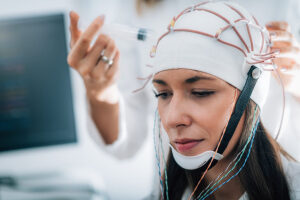Dieser Beitrag ist auch verfügbar auf:
Deutsch
1. A revolution through automation
The ability of AI to analyze huge amounts of data in the shortest possible time and gain insights from it enables unprecedented automation and optimization in numerous industries.
1.1. More precise diagnoses and personalized therapies in healthcare
The healthcare sector has made enormous progress through the use of AI. AI not only enables faster but also more precise diagnoses and opens up new avenues in patient care.
Early detection of medical conditions
AI systems such as AlphaFold from Alphabet DeepMind (USA) and IBM Watson Health (USA) are revolutionizing the diagnosis of serious diseases. They are able to identify complex patterns in medical data that are often hidden from human doctors.
- AI’s advanced pattern recognition can detect microscopic tumors on X-rays before they cause symptoms. Studies show that AI models can detect early-stage breast cancer more reliably than human radiologists.
- AI-powered systems analyze ECGs, blood pressure readings, and other health data to identify the risk of heart attack or stroke. These early warning systems enable preventive measures to be taken before serious complications occur.
Robot-assisted surgery
Surgical robots such as the Da Vinci Surgical System from the USA support doctors during complicated operations. With the help of AI, these systems can perform operations with extreme precision.
The use of AI also allows for minimally invasive operations that cause less tissue damage and therefore offer faster recovery times. The risks of complications and infections are also significantly reduced.
Virtual health assistants
Platforms such as Babylon Health (United Kingdom) and Ada Health (Germany) use AI to advise patients in real time. These virtual assistants analyze symptoms and make recommendations as to whether a visit to the doctor is necessary. They facilitate access to healthcare and at the same time reduce the workload of medical staff.
.1.2. Better quality control through smart systems in the manufacturing industry
AI has the potential to usher in a new era of automation in the manufacturing industry. Intelligent control systems can increase productivity and quality while reducing costs.
Predictive maintenance
Companies such as Siemens (Germany) and General Electric (USA) rely on predictive maintenance. Sensors monitor the condition of machines in real time and report potential problems before a breakdown occurs. This method significantly minimizes production interruptions and reduces maintenance costs. It also extends the service life of the machines.
Autonomous robots
AI-controlled robots, such as the models by ABB Robotics (Germany). are becoming more common in factories. These machines perform tasks such as assembly, welding or quality control. They can adapt quickly to changing production requirements and ensure consistently high quality.
1.3. Higher security and faster transactions in the financial sector
AI algorithms analyze large amounts of financial data in fractions of a second and make automated trading decisions. Hedge funds such as Renaissance Technologies (USA) use these systems to identify market trends and make profitable trades. This type of speed and precision is unattainable for humans.
Improved fraud detection
Banks such as HSBC (London) and JPMorgan (USA) use AI to identify suspicious transactions. HSBC and JPMorgan use various AI tools to detect financial crime more efficiently. These include an anti-money laundering AI (AML AI) from Google and the “Decision Intelligence” platform by Quantexa (UK).
1.4. Precision farming for higher yields in agriculture
AI is also making agriculture more efficient and sustainable. From harvest monitoring to the automation of agricultural machinery, AI is making cultivation more precise and resource-efficient.
AI-controlled drones and sensors
Farmers are using drones and soil sensors equipped with artificial intelligence. These collect data on soil quality, moisture and plant growth. Farmers can use this information to take targeted measures, such as dosing fertilizers or optimal irrigation.
Autonomous tractors
Manufacturers such as John Deere (USA) are developing tractors that can plow, sow and harvest fields without human control. These machines work independently of the time of day or weather conditions.
2. Blockchain technology: decentralization combined with more transparency
2.1. Cryptocurrencies and more in the financial sector
Blockchain technology offers far more than just the basis for cryptocurrencies. Apps such as Ripple (USA) enable lightning-fast and cost-effective transactions across national borders – without the need for banks as intermediaries.
Platforms such as Aave (Switzerland) or Uniswap (USA) are based on the concept of Decentralized Finance (DeFi). In DeFi, Financial services such as loans or trading take place directly as blockchain entries without the need for banks.
2.2. Faster and more secure trading in the real estate sector
- Blockchain technology makes it possible to tokenize real estate. Platforms such as RealT (USA) allow investors to acquire shares in real estate with small amounts.
- Transparent land registers: Countries such as Sweden and Georgia are already using blockchain to digitize land registers and make transactions more transparent.
.2.3. Efficiency through better tracking in supply chain management
The well-known US supermarket chain Walmart uses blockchain to track the path of products such as fruit, vegetables and meat from the farm to supermarket shelves. This allows contaminated goods to be identified as quickly as possible and recalls to be carried out more efficiently. In addition, companies such as Louis Vuitton, Prada and Hublot use blockchain solutions to guarantee the authenticity of their luxury products.
2.4. Trading surplus electricity in the energy sector
Platforms such as Power Ledger (Australia) enable homeowners to sell surplus solar power directly to their neighbors. The infrastructure can be provided by projects such as the ION Power Grid.
ION Power Grid is a decentralized energy trading and distribution network and enables the exchange of energy between individual users, focusing on a smart and scalable energy infrastructure. ION Power Grid aims to enable energy exchange on a peer-to-peer basis and to increase the efficiency and transparency of the energy market. Blockchain technology ensures transparency and equity.
3. Lack of sustainability as the downside to many digital innovations
The potential applications of AI and blockchain are impressive, but they also come at a high price.
- AI models, especially in the area of deep learning, require immense computing power. Training large language models such as GPT creates a carbon footprint that can be equivalent to that of hundreds of transatlantic flights or the energy consumption of a medium-sized city.
- The “proof of work” process used by Bitcoin is also extremely energy intensive. The Bitcoin network consumes more electricity than some countries.
- Data centers operated by large cloud providers require huge amounts of electricity to operate. They are the backbone for AI models, blockchain transactions and hosting digital platforms. According to estimates, data centers worldwide account for around 2-3 percent of global electricity consumption.
4. These innovations could enable a sustainable future
There are already various promising approaches to reducing the energy consumption of AI and blockchain implementations:
- Methods such as pruning and federated learning ensure more efficient AI models with lower energy consumption. Pruning refers to the removal of unimportant or redundant neurons and connections in a neural network in order to reduce the size and computational load. Federated learning, on the other hand, is an approach in which a model is trained decentrally on multiple devices without the need to collect their data centrally.
- The Ethereum blockchain recently abandoned the energy-intensive “proof-of-work” mechanism and switched to the energy-efficient “proof-of-stake” method. This technique requires over 99 percent less energy.
- Data centers and blockchain networks are increasingly relying on renewable energy to improve their carbon footprint.
- Another approach to reducing the energy consumption of data centers is to use water or natural cooling instead of conventional air cooling. This method can significantly reduce energy consumption for cooling servers. Meta/Facebook employs free cooling in some of its data centers, which uses cold outside air directly. This reduces the need for energy-intensive air conditioning.
- AI is already being used to optimize energy consumption in various industries. For example, AI-powered algorithms help predict power demands to optimize power distribution in real time and reduce overall energy consumption. Google has deployed its DeepMind AI in its data centers to optimize cooling needs and reduce power consumption by 40 percent.






